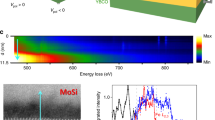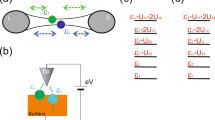Abstract
The excitation spectrum in superconducting lead in the presence of a metallic contact has been investigated. Conductance versus voltage curves disagree with those computed from the BCS theory but agree much better with curves calculated from a depairing theory. The experiments demonstrate the existence of a pair breaking mechanism induced by metallic contact. Tunnelling into the normal side of the double layer gave less conclusive results. Due to a pair enhancing effect, superconductivity exists in the otherwise normal metal, but it cannot be described by the simple BCS picture. A somewhat complicated temperature dependence was registered for the sharpness of the conductance versus voltage curves.
Résumé
On a étudié le spectre d'excitation du plomb supraconducteur en présence d'un contact métallique. Les courbes de la conductibilité électrique en fonction de la tension électrique ne coincident pas avec celles calculées à partir de la théorie BCS, mais elles sont mieux décrites par une théorie de découplage de paires.
Les expériences démontrent qu'un tel mécanisme est provoqué par le contact métallique. Les caractéristiques tunnel obtenues sur la face normale de la couche double donnent des résultats moins conclusifs. Á cause de l'augmentation de la probabilité de formation des paires, la phase supraconductrice existe aussi dans le métal en général normal, mais on ne peut pas la décrire par un simple modèle BCS.
On a aussi constaté que la largeur des courbes de conductibilité électrique en fonction de la tension électrique est une fonction assez compliquée de la température.
Zusammenfassung
Das Anregungsspektrum von supraleitendem Blei in Kontakt mit einem Metall wurde untersucht. Die Strom-Spannungscharakteristiken stimmen nicht mit denen nach der BCS-Theorie zu erwartenden überein, entsprechen jedoch den aus einer „Entpaarungstheorie” berechneten Kurven viel besser. Die Versuche weisen die Existenz eines „Entpaarungsmechanismus” bei metallischem Kontakt nach. Transmissionen in die normale Seite einer Doppelschicht hinein ergaben weniger schlüssige Ergebnisse. Auf Grund eines „Paar-Vermehrungseffektes” besteht ein supraleitender Zustand in sonst normalem Metall, aber das einfache BCS-Bild genügt zu dessen Beschreibung nicht. Die Schärfe des Strom-Spannungsverlaufs zeigt eine eher komplizierte Temperaturabhängigkeit.
Similar content being viewed by others
References
Hilsch, P.: Z. Physik167, 511 (1962);Bergmann, G.: Z. Physik187, 395 (1965);Hauser, J. J., H. C. Theurer, andN. R. Werthamer: Phys. Rev.142, 118 (1966);de Gennes, P. G.: Rev. Mod. Phys.36, 225 (1964).
Fulde, P., andK. Maki: Phys. Rev. Letters15, 675 (1965).
Abrikosov, A. A., andL. P. Gor'kov: Zh. Eksperim. Teor. Fiz.39, 1781 (1960); Engl. Transl. Soviet Phys.-JETP12, 1243 (1961).
Woolf, M. A., andF. Reif: Phys. Rev.137, A 557 (1965).
Skalski, S., O. Betbeder-Matibet, andP. R. Weiss: Phys. Rev.136, A 1500 (1964).
Maki, K.: Prog. Theor. Phys. (Kyoto)29, 10, 333, 603 (1963).
Guyon, E., A. Martinet, J. Matricon, andP. Pincus: Phys. Rev.138, A 746 (1965);Tomasch, W. J.: Phys. Letters9, 104 (1964).
Maki, K., andP. Fulde: Phys. Rev.140, A 1586 (1965).
de Gennes, G., andS. Mauro: Solid State Comm.3, 381 (1965).
Fulde, P., andK. Maki: to be published.
Smith, P. H., S. Shapiro, J. L. Miles, andJ. Nicol: Phys. Rev. Letters6, 686 (1961).
Claeson, T., andS. Gygax: Solid State Comm.4, 385 (1966).
Hauser, J. J.: Physics2, 247 (1966).
Adkins, C. J., andB. W. Kington: Phil. Mag.10, 971 (1966).
Tsuya, H.: J. Phys. Soc. Japan21, 1011 (1966).
Guyon, E., A. Martinet, S. Mauro, andF. Meunier: Phys. kondens. Materie5, 123 (1966).
Bermon, S.: Technical Report No. 1 on NSFGP 1100, Physics Dept., University of Illinois, 1964 (unpublished).
Bardeen, J., L. N. Cooper, andJ. R. Schrieffer: Phys. Rev.108, 1175 (1957).
Zaitzev, R. O.: Zh. Eksperim. Teor. Fiz.48, 644 and 1759 (1965); English Transl. Soviet Phys.-JETP21, 426 and 1178 (1965).
Hansen, M.: Constitution of Binary Alloys. New York: McGraw-Hill Book Company, Inc., 1958.
Giaver, I., andK. Megerle: Phys. Rev.122, 1101 (1961);Patterson, W. R., andJ. Shewchun: Rev. Sci. Instr.35, 1704 (1964);Thomas, D. E., andJ. M. Rowell: Rev. Sci. Instr.36, 1301 (1965).
Dijk, H. von,M. Durieux,J. R. Clement, andJ. K. Logan: Natl. Bur. Std. (U.S.) Monograph10, part 2, 12 (1960).
Giaver, I., H. R. Hart, Jr., andK. Megerle: Phys. Rev.126, 941 (1962).
Frerichs, R., andJ. P. Wilson: Phys. Rev.142, 264 (1966).
Rowell, J. M., andL. Y. L. Shen: Phys. Rev. Letters17, 15 (1966).
Appelbaum, J.: Phys. Rev. Letters17, 91 (1966);Anderson, P. W.: Phys. Rev. Letters17, 95 (1966).
Rowell, J. M., andW. L. McMillan: Phys. Rev. Letters16, 453 (1966).
Author information
Authors and Affiliations
Additional information
Supported in part by the U.S. Air Force Office of Scientific Research and Statens Naturvetenskapliga Forskningsråd.
Previously at University of California, San Diego; La Jolla.
Rights and permissions
About this article
Cite this article
Claeson, T., Gygax, S. & Maki, K. Proximity effect in superconducting contacts by electron tunnelling. Phys kondens Materie 6, 23–37 (1967). https://doi.org/10.1007/BF02422520
Received:
Issue Date:
DOI: https://doi.org/10.1007/BF02422520




